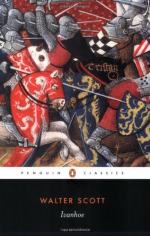|
This section contains 2,537 words (approx. 9 pages at 300 words per page) |

|
SOURCE: "The Anti-Romantic in Ivanhoe" in Nineteenth-Century Fiction, Vol. 9, No. 4, March, 1955, pp. 293-300.
In the following essay, Duncan argues, against earlier critics, that Ivanhoe is "neither juvenile nor romantic" but is a serious examination of the transition between a period of heroic adventure and one of stable development.
Is Sir Walter Scott's Ivanhoe essentially a romantic book of adventure—preferably for boys? A number of usually perceptive critics have treated it as such. Walter Bagehot declared that the novel expressed a great "romantic illusion" and that it was addressed "to that kind of boyish fancy which idolizes medieval society as the 'fighting time.'" Eighty years later Sir Herbert Grierson asserted that Ivanhoe was "mainly a good story of adventure for boys." Una Pope-Hennessy agreed that the novel was "first and last a boy's book" and explained that for Scott medieval England was "all a wonderful pageant-land" and...
|
This section contains 2,537 words (approx. 9 pages at 300 words per page) |

|


